正在载入交互式动画窗口请稍等
Prim(普里姆)算法 可视化交互式动画版

Prim的算法简介:
我们已经讨论了 最小生成树的 Kruskal 算法 。 与Kruskal算法一样,Prim算法也是一种 贪心算法 。 该算法始终从单个节点开始,然后移动到多个相邻节点,以便探索沿途所有连接的边。
该算法从空的生成树开始。 这个想法是维护两组顶点。 第一个集合包含已包含在 MST 中的顶点,另一个集合包含尚未包含在 MST 中的顶点。 在每一步中,它都会考虑连接两个集合的所有边,并从这些边中选择最小权重边。 拾取边后,它将边的另一个端点移动到包含 MST 的集合。
连接图中两组顶点的一组边 在图论中称为割 。 因此,在 Prim 算法的每一步中,找到一个切割,从切割中选取最小权重边,并将该顶点包含在 MST 集合(包含已包含顶点的集合)中。
Prim 算法如何工作?
Prim 算法的工作原理可以通过以下步骤来描述:
步骤1: 确定任意一个顶点作为MST的起始顶点。
步骤2: 按照步骤3到5,直到出现未包含在MST中的顶点(称为边缘顶点)。
步骤3: 找到连接任意树顶点和边缘顶点的边。
第四步: 找到这些边中的最小值。
步骤5: 如果选择的边不形成任何环,则将其添加到MST中。
步骤6: 返回MST并退出
注意: 为了确定环,我们可以将顶点分为两组[一组包含MST中包含的顶点,另一组包含边缘顶点。]
Prim算法说明:
以下图为例,我们需要找到最小生成树(MST)。
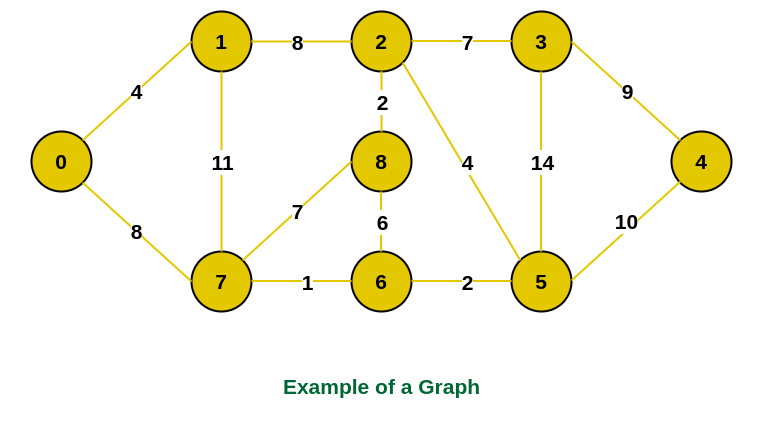
图表示例
步骤1: 首先,我们选择一个任意顶点作为最小生成树的起始顶点。 这里我们选择顶点 0 作为起始顶点。
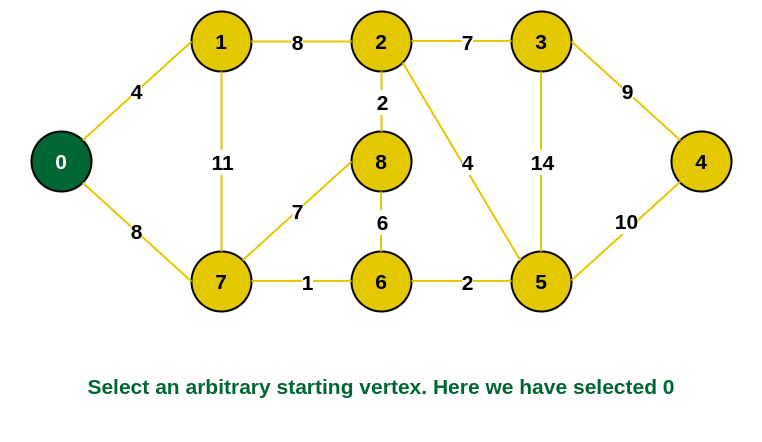
选择 0 作为起始顶点
步骤2: 连接不完整MST和其他顶点的所有边都是边{0, 1}和{0, 7}。 在这两者之间,权重最小的边是{0, 1}。 因此,将边和顶点 1 包含在 MST 中。
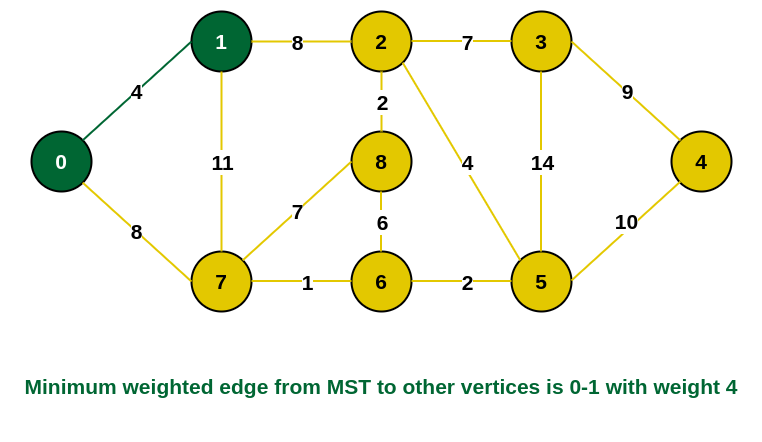
MST中添加1
步骤3: 连接不完整MST到其他顶点的边是{0, 7}、{1, 7}和{1, 2}。 在这些边中,边{0, 7}和{1, 2}的最小权重为8。 让我们在 MST 中包含边 {0, 7} 和顶点 7。 [我们还可以在 MST 中包含边 {1, 2} 和顶点 2]。
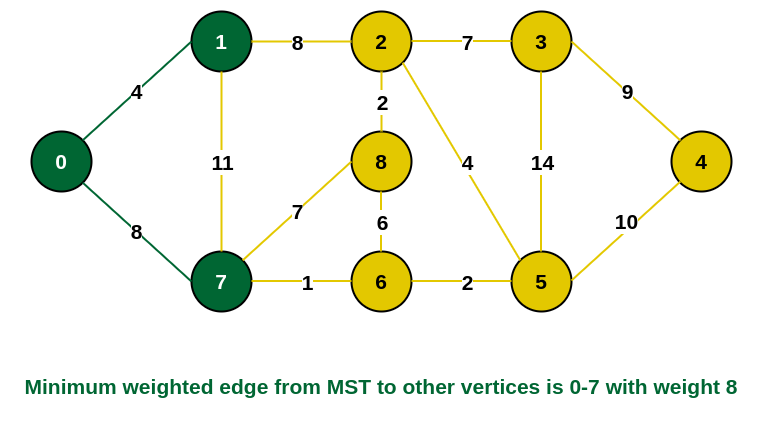
MST中添加7
步骤4: 连接不完整MST与边缘顶点的边为{1, 2}、{7, 6}和{7, 8}。 将边 {7, 6} 和顶点 6 添加到 MST 中,因为它的权重最小(即 1)。
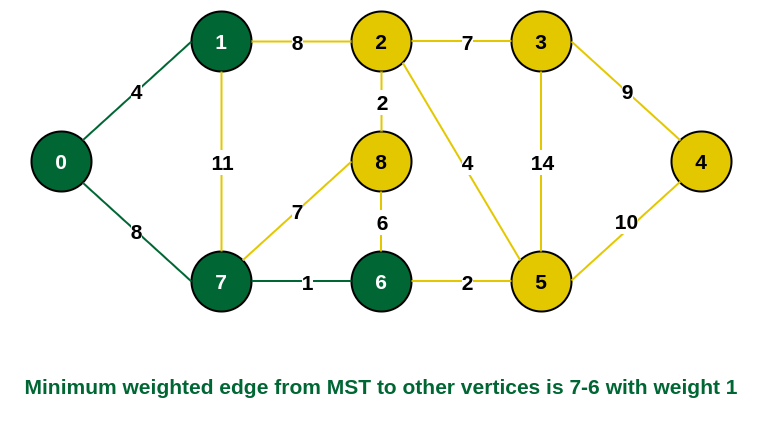
MST中添加6
第 5 步: 连接边现在为 {7, 8}、{1, 2}、{6, 8} 和 {6, 5}。 将边{6, 5}和顶点5包含在MST中,因为其中边的权重最小(即2)。

将顶点 5 包含在 MST 中
步骤6: 当前连接边中,边{5, 2}的权重最小。 因此,将该边和顶点 2 包含在 MST 中。
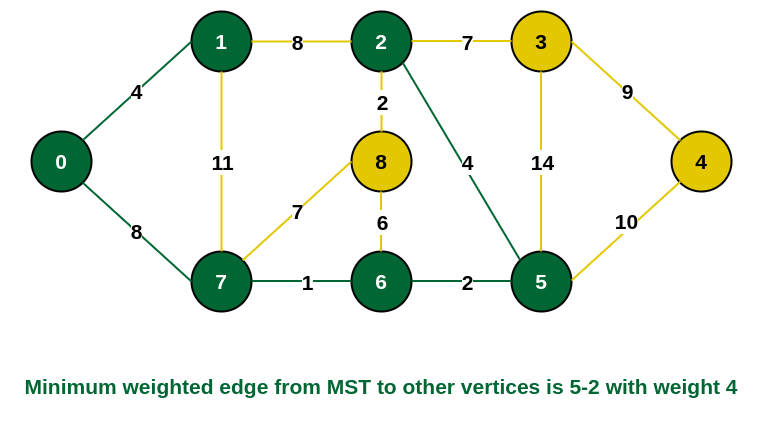
将顶点 2 包含在 MST 中
步骤7: 不完整MST与其他边的连接边为{2, 8}、{2, 3}、{5, 3}和{5, 4}。 权重最小的边是边 {2, 8},其权重为 2。因此,将该边和顶点 8 包含在 MST 中。

在 MST 中添加顶点 8
步骤8: 看到这里,边{7, 8}和{2, 3}都具有相同的权重,并且权重最小。 但 7 已经是 MST 的一部分。 因此,我们将考虑边 {2, 3} 并将该边和顶点 3 包含在 MST 中。
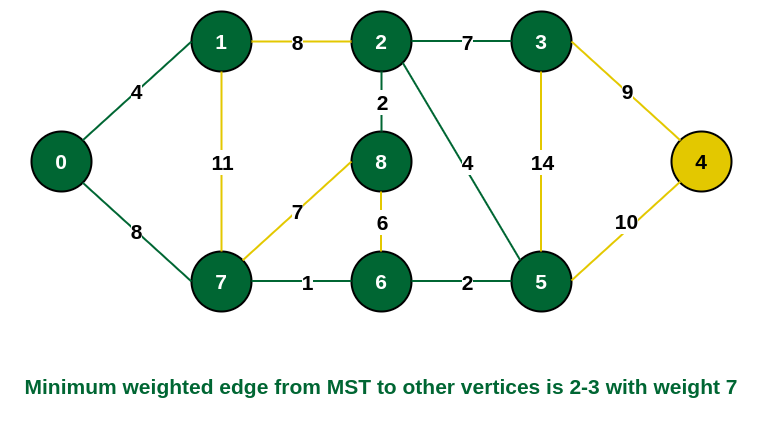
在 MST 中包含顶点 3
步骤9: 仅保留顶点4。 从不完整的MST到4的最小加权边是{3, 4}。
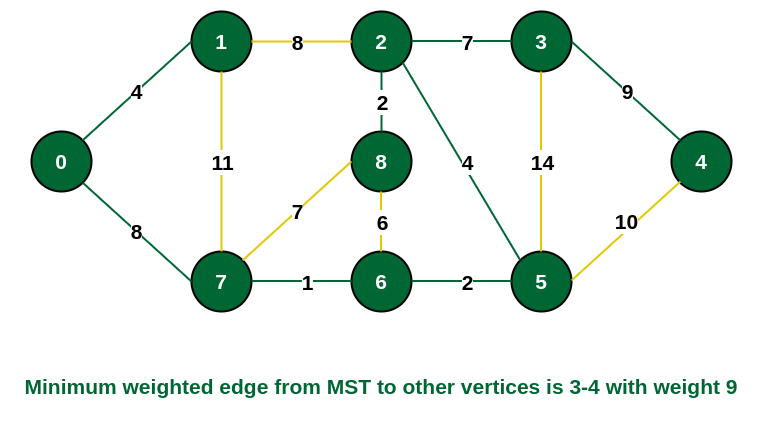
将顶点 4 包含在 MST 中
MST的最终结构如下,MST边的权重为 (4 + 8 + 1 + 2 + 4 + 2 + 7 + 9) = 37 。
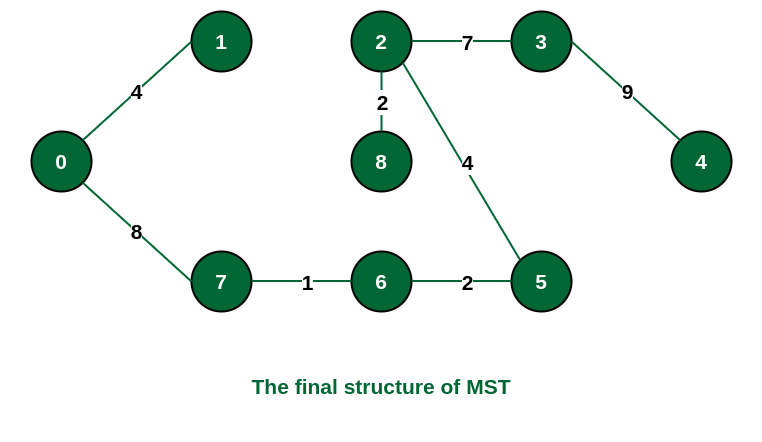
使用上述方法形成的MST的结构
注意: 如果我们在第三步中选择了边 {1, 2},则 MST 将如下所示。
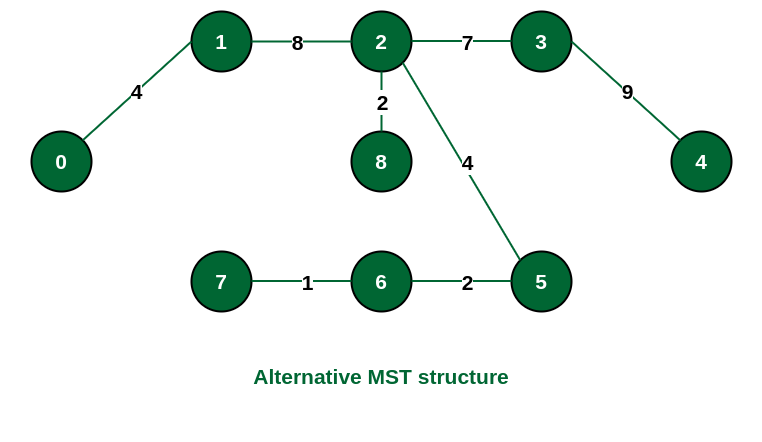
如果我们在 MST 中选择了边 {1, 2},则备用 MST 的结构
如何实现Prim算法?
按照给定的步骤使用上面提到的 Prim 算法 来查找图的 MST:
- 创建一个 mstSet 集来跟踪已包含在 MST 中的顶点。
- 为输入图中的所有顶点分配一个键值。 将所有键值初始化为 INFINITE。 将第一个顶点的键值指定为 0,以便首先选取它。
-
虽然
mstSet
不包含所有顶点
- 选择一个不在 mstSet 中且具有最小键值的 顶点 u 。
- 将u 包含 在 mstSet 中。
-
更新u
所有相邻顶点的键值
。
要更新键值,请迭代所有相邻顶点。
- 对于每个相邻顶点 v ,如果边 uv 的权重 小于 v 的前一个键值,则将键值更新为 uv 的权重。
使用关键值的想法是从 切割 中选取最小权重边缘。 键值仅用于尚未包含在 MST 中的顶点,这些顶点的键值表示将它们连接到 MST 中包含的顶点集的最小权重边。
下面是该方法的实现:
- C++
- C
- Java
- Python3
- C#
- JavaScript
C++
// A C++ program for Prim's Minimum// Spanning Tree (MST) algorithm. The program is// for adjacency matrix representation of the graph#include <bits/stdc++.h>using namespace std;// Number of vertices in the graph#define V 5// A utility function to find the vertex with// minimum key value, from the set of vertices// not yet included in MST
int minKey(int key[], bool mstSet[]){ // Initialize min value int
min = INT_MAX, min_index; for (int v = 0; v < V; v++) if (mstSet[v] == false && key[v] < min)
min = key[v], min_index = v; return min_index;}// A utility function to print the// constructed MST stored in parent[]void printMST(int parent[], int graph[V][V]){ cout << "Edge \tWeight\n"; for (int i = 1; i < V; i++) cout << parent[i] << " - "
<< i << " \t" << graph[i][parent[i]] << " \n";}// Function to construct and print MST for// a graph represented using adjacency// matrix representation
void primMST(int graph[V][V]){ // Array to store constructed MST int
parent[V]; // Key values used to pick minimum weight edge in cut int
key[V]; // To represent set of vertices included in MST bool mstSet[V]; // Initialize all keys as INFINITE for (int i = 0; i < V; i++) key[i] = INT_MAX, mstSet[i] = false; // Always include first 1st vertex in MST. // Make key 0 so that this vertex is picked as first // vertex. key[0] = 0;
// First node is always root of MST parent[0] = -1; // The MST will have V vertices for (int count = 0; count < V - 1; count++) { // Pick the minimum key vertex from the // set of vertices not yet included in MST int u = minKey(key, mstSet); // Add the picked vertex to the MST Set mstSet[u] = true; // Update key value and parent index of // the adjacent vertices of the picked vertex. // Consider only those vertices which are not // yet included in MST for (int v = 0; v < V; v++) // graph[u][v] is non zero only for adjacent // vertices of m mstSet[v] is false for vertices // not yet included in MST Update the key only // if graph[u][v] is smaller than key[v] if (graph[u][v] && mstSet[v] == false && graph[u][v] < key[v]) parent[v] = u, key[v] = graph[u][v]; } // Print the constructed MST printMST(parent, graph);}// Driver's codeint main(){ int
graph[V][V] = { { 0, 2, 0, 6, 0 }, { 2, 0, 3, 8, 5 }, { 0, 3, 0, 0, 7 }, { 6, 8, 0, 0, 9 }, { 0, 5, 7, 9, 0 } }; // Print the solution primMST(graph); return 0;}// This code is contributed by rathbhupendra |
C
Java
Python3
C#
Javascript
边重 0 - 1 2 1 - 2 3 0 - 3 6 1 - 4 5
时间复杂度:
O(V
2
),如果输入
图使用邻接表表示
,那么Prim算法的时间复杂度可以借助二叉堆降低到O(E * logV)。
在这个实现中,我们总是考虑生成树从图的根开始
辅助空间:
O(V)
Prim算法的其他实现:
下面给出了 Prim 算法的一些其他实现
- 用于邻接矩阵表示的 Prim 算法 – 在本文中,我们讨论了在图由邻接矩阵表示的情况下实现 Prim 算法的方法。
- Prim 的邻接列表表示算法 – 在本文中,Prim 的算法实现针对由邻接列表表示的图进行了描述。
- 使用优先级队列的 Prim 算法: 在本文中,我们讨论了一种实现 Prim 算法的省时方法。
PRIM算法的优化方法:
直觉
- 我们使用ArrayList<ArrayList<Integer>> 将邻接矩阵转换为邻接列表 。
- 然后我们创建一个 Pair 类来存储顶点及其权重。
- 我们根据最低权重对列表进行排序。
- 我们创建优先级队列并将第一个顶点及其权重推入队列中
- 然后我们遍历它的边并将最小的权重存储在一个名为 ans 的变量中。
- 最后,在所有顶点之后,我们返回 ans。
执行
- C++
- Java
- Python3
C++
#include<bits/stdc++.h>using namespace std;typedef pair<int,int> pii;// Function to find sum of weights of edges of the Minimum Spanning Tree.
int spanningTree(int V, int E, int edges[][3]){ // Create an adjacency list representation of the graph vector<vector<int>> adj[V]; // Fill the adjacency list with edges and their weights for (int i = 0; i < E; i++) { int u = edges[i][0]; int v = edges[i][1]; int wt = edges[i][2]; adj[u].push_back({v, wt}); adj[v].push_back({u, wt}); } // Create a priority queue to store edges with their weights priority_queue<pii, vector<pii>, greater<pii>> pq;
// Create a visited array to keep track of visited vertices vector<bool> visited(V, false); // Variable to store the result (sum of edge weights) int
res = 0; // Start with vertex 0 pq.push({0, 0}); // Perform Prim's algorithm to find the Minimum Spanning Tree while(!pq.empty()){ auto p = pq.top(); pq.pop(); int wt = p.first; // Weight of the edge int u = p.second; // Vertex connected to the edge if(visited[u] == true){ continue; // Skip if the vertex is already visited } res += wt; // Add the edge weight to the result visited[u] = true; // Mark the vertex as visited
// Explore the adjacent vertices for(auto v : adj[u]){ // v[0] represents the vertex and v[1] represents the edge weight
if(visited[v[0]] == false){ pq.push({v[1], v[0]}); // Add the adjacent edge to the priority queue } } } return res; // Return the sum of edge weights of the Minimum Spanning Tree}int main(){ int
graph[][3] = {{0, 1, 5}, {1, 2, 3}, {0, 2, 1}}; // Function call cout << spanningTree(3, 3, graph) << endl; return 0;} |
Java
Python3
4
时间复杂度:
O(E*log(E)),其中 E 是边数
辅助空间:
O(V^2),其中 V 是顶点数
Prim 寻找最小生成树(MST)的算法:
优点:
- Prim 的算法保证在连通的加权图中找到 MST。
- 使用二叉堆或斐波那契堆的时间复杂度为 O(E log V),其中 E 是边数,V 是顶点数。
- 与其他一些 MST 算法相比,它是一种易于理解和实现的相对简单的算法。
缺点:
- 与 Kruskal 算法一样,Prim 算法在具有许多边的密集图上可能会很慢,因为它需要对所有边至少迭代一次。
- Prim 的算法依赖于优先级队列,这会占用额外的内存并在非常大的图上减慢算法的速度。
- 起始节点的选择会影响 MST 输出,这在某些应用中可能是不可取的。